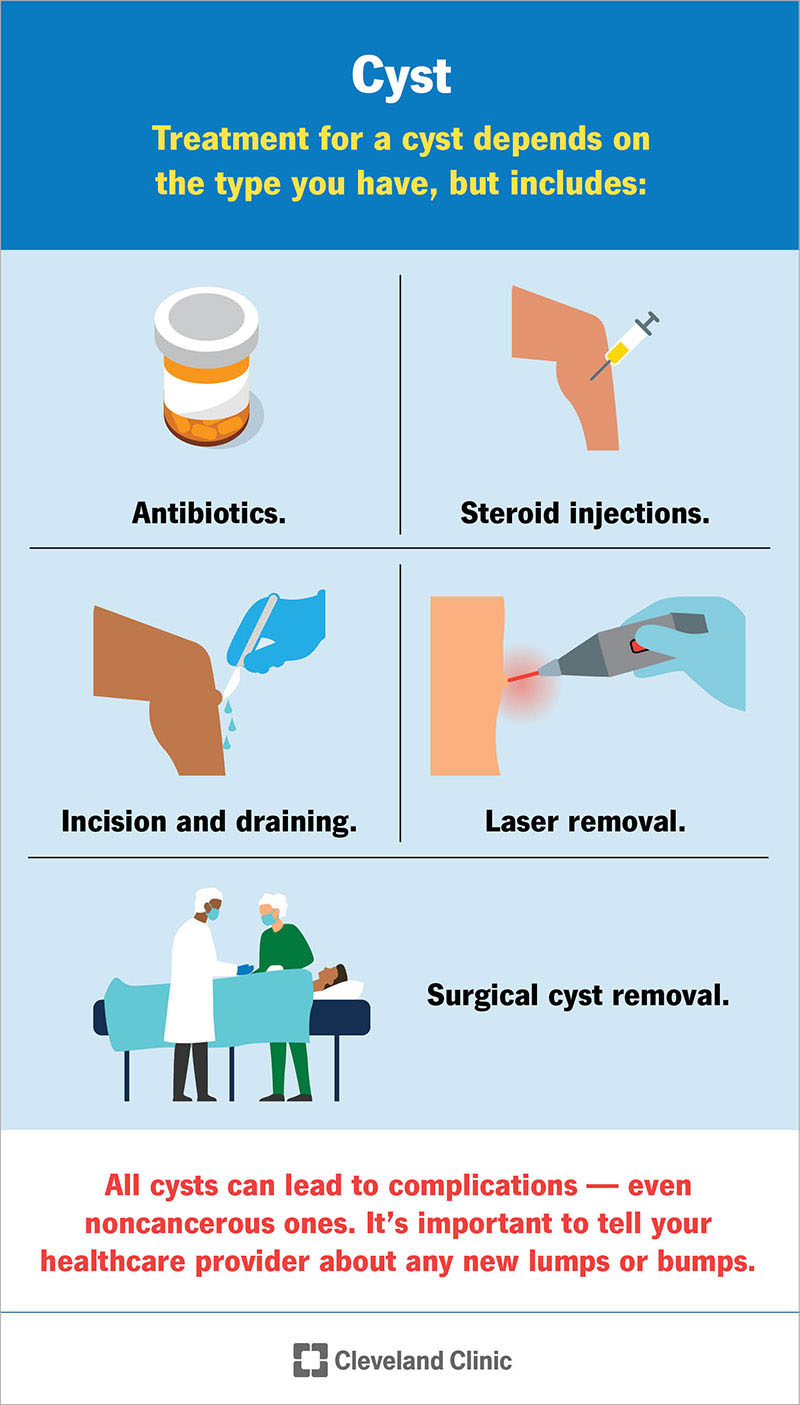Cysts are fluid-filled lumps that can form anywhere in your body — including your skin, breasts, ovaries and kidneys. Most cysts aren’t cancerous, but some can be. So, it’s important to tell your healthcare provider if you notice a new lump. They can figure out the cause and whether you need treatment.
Advertisement
Cleveland Clinic is a non-profit academic medical center. Advertising on our site helps support our mission. We do not endorse non-Cleveland Clinic products or services. Policy

A cyst is a closed sac of tissue that can form anywhere in your body. These lumps or bumps most commonly develop in your skin, breasts, ovaries and kidneys. Cysts look like pouches or pockets. They’re usually filled with fluid, pus, air or other materials.
Advertisement
Cleveland Clinic is a non-profit academic medical center. Advertising on our site helps support our mission. We do not endorse non-Cleveland Clinic products or services. Policy
Cysts may look alarming, but they’re typically not serious. Your healthcare provider will let you know if you need treatment.
Cysts are usually benign. That means they’re noncancerous. Benign cysts are mostly harmless, but they may cause pain or discomfort. Cysts may be an issue when they happen somewhere sensitive, like around nerves or your brain.
Rarely, cysts can be precancerous or cancerous (malignant). You should always tell your healthcare provider any time you notice a new lump or bump. This is especially true if it doesn’t go away after several days or doesn’t stop growing.
There are many types of cysts. They can have different features depending on which area of your body they affect.
Skin cysts include:
Cysts that can form inside your body include:
Advertisement
Cyst symptoms vary widely depending on the type you have and the location of the cyst. You could develop:
Some cysts don’t cause symptoms at all. Others are visible but painless. An infected cyst can become painful and swollen. It may drain or burst (rupture) if you don’t get treatment.
Cysts form for many different reasons. But sometimes, they appear randomly and without an obvious cause.
Some known causes of cysts include:
Left untreated, cancerous (malignant) cysts can cause cancer cells to spread beyond the lump to other parts of your body.
Noncancerous (benign) cysts can grow larger and press on surrounding structures in your body. This can lead to possible pain and other complications. Benign cysts can also get infected (become an abscess). If an abscess ruptures inside your body, you could develop a blood infection.
All cysts can lead to complications — even noncancerous ones. That’s why it’s important to tell your healthcare provider about any new lumps or bumps you notice.
A healthcare provider will start with a physical exam. If you have a visible cyst, they’ll look and gently feel around the area.
In some cases, your provider may ask to run some tests. These could include imaging tests, like X-rays, ultrasounds or CT scans. These tests can help your provider see cysts on the inside of your body.
You may also need a fine-needle aspiration (FNA). This is a type of biopsy. A provider uses a needle and syringe to pull fluid out of a cyst. Then, they send the fluid sample to a lab for testing. This can help your provider figure out the type of cyst you have and whether you need treatment.
Some cysts go away on their own without treatment. But you should still tell your healthcare provider right away if you develop a lump, even if it seems harmless. They may recommend treatment in some cases. Or they may want to observe the cyst for a few days or weeks before making any decisions.
Healthcare providers use several treatment methods. Depending on which type you have, cyst treatments may include:
Advertisement
If you’re wondering how to get rid of a cyst, don’t try to drain it or remove it yourself. That includes poking it or using something sharp to break it open. This can lead to serious complications, like a skin infection or blood poisoning.
But there are some things you can do at home to ease your symptoms:
You should tell your healthcare provider any time you notice:
The overall outlook is good if you have a cyst. They’re common and rarely cancerous. But even if you have a benign cyst, you might need treatment. So, it’s always best to see a healthcare provider.
Yes, cysts can rupture (burst). Whether a rupture causes symptoms depends on the type and location of the cyst. A ruptured skin cyst may cause mild symptoms or none at all. But a ruptured ovarian cyst could cause more severe symptoms, like abdominal pain or bleeding.
Pimples differ from cysts because they don’t have a sac. But some people develop something similar called cystic acne. With this condition, cysts form deep under your skin instead of near the surface like a pimple.
Advertisement
Finding a lump that wasn’t there before can feel scary. In addition to cysts, there are many other types of lumps and bumps that can form throughout your body. Most are harmless. Still, you should see your healthcare provider any time you notice a new or changing lump. They can help you figure out what caused it and tell you whether you need treatment.
Advertisement
Cleveland Clinic’s primary care providers offer lifelong medical care. From sinus infections and high blood pressure to preventive screening, we’re here for you.

Last reviewed on 11/14/2025.
Learn more about the Health Library and our editorial process.